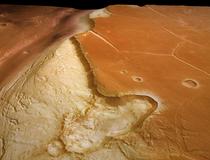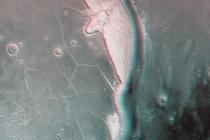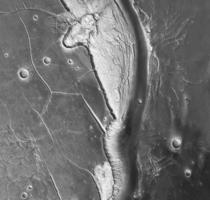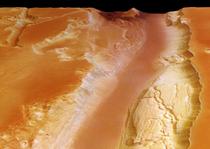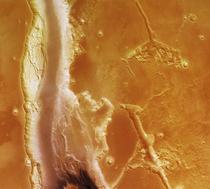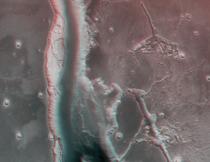Navigation/Menü: Links auf weitere Seiten dieser Website und Banner
30.08.2006
HRSC Press Release #290 - Kasei Valles (orbit 1429)
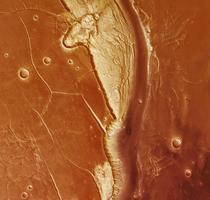 RGB Farbbild: Kasei Nord |
On 26 February 2005 the High-Resolution Stereo Camera (HRSC) onboard the ESA spacecraft Mars Express obtained image data in orbit 1429 with a ground resolution of approximately 29 metres per pixel. The data were acquired in the region of Kasei Valles, between 21° and 28° northern latitude at 292.5° eastern longitude.
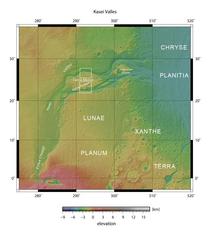 Kontextkarte |
Kasei Valles is one of the biggest outflow channel systems on Mars, and which probably has been formed by gigantic flood events. It was additionally shaped by glacial activity. Connecting the southern Echus Chasma and the plain Chryse Planitia in the east, Kasei Valles has a width of roughly 500 kilometres and, if Echus Chasma is included, extends for approximately 2500 kilometres. Both valley branches shown in the image scenes exhibit a depth of 2900 metres.
Kasei NordDie erste Szene zeigt den nördlichen Arm von Kasei Valles und die Ebene Sacra Mensa. Am westlichen Rand der Szene fällt eine ovale Struktur auf, die wahrscheinlich von einem flachwinkligen Meteoriteneinschlag verursacht wurde.
In the first scene the northern branch of Kasei Valles and the plain Sacra Mensa can be seen. An oval structure at the western edge of the scene is interpreted as a crater caused by an oblique meteorite impact. |
|
||||||
Kasei SüdDie zweite Szene zeigt den südlichen Arm von Kasei Valles neben Sacra Mensa mit ihrem ein bis zwei Kilometer tiefen Grabensystem Sacra Fossae. An beiden Seitenhängen des Talarms sind bis zu 30 Kilometer breite Terrassen erkennbar.
The southern branch of Kasei Valles and Sacra Mensa with its 1-2 kilometres deep graben system Sacra Fossae is shown in the second scene. Up to 30 kilometres wide are the terraces which follow the slopes on both sides of the valley branch. |
|
||||||
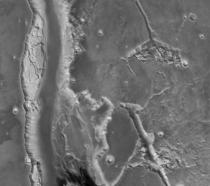 Nadiraufnahme: Kasei Süd |
The colour scenes have been derived from the three HRSC-colour channels and the nadir channel. The perspective views have been calculated from the digital terrain model derived from the stereo channels. The anaglyph image was calculated from the nadir and one stereo channel. The black and white high resolution images were derived form the nadir channel which provides the highest detail of all channels.
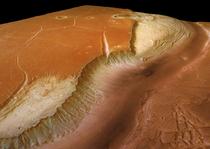 Perspektive: Kasei Nord #1 |
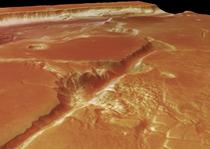 Perspektive: Kasei Süd #2 |
Download
hochaufgelöste Bilddaten / high resolution image data
| Kontextkarte: |
| Nadiraufnahme: Kasei Nord: |
| Nadiraufnahme: Kasei Süd: |
| RGB Farbbild: Kasei Nord: |
| RGB Farbbild: Kasei Süd: |
| Rot-Cyan Anaglyphe: Kasei Nord: |
| Rot-Cyan Anaglyphe: Kasei Süd: |
| Perspektive: Kasei Nord #1: |
| Perspektive: Kasei Nord #2: |
| Perspektive: Kasei Süd #1: |
| Perspektive: Kasei Süd #2: |
© Copyright: ESA/DLR/FU Berlin (G. Neukum)

 English
English

